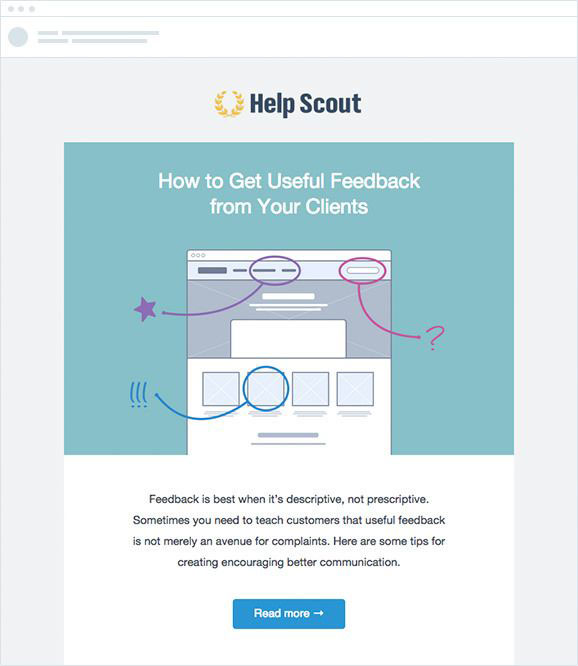Allow us to open your eyes: there is no such thing as a perfect email. The mail that works best for your competitor will probably not perform equally well for your business. After all, there is a reason why his customers have chosen him instead of you. Then why this article? To explore this subject together with you.
What makes people click?
Look at your inbox. What triggers you to read and what does not? Which topics made you click through? Remember that you are only a guest in their inbox and that you are not the only one. You may think your email is very special, but chances are that to the reader your email looks exactly like the rest. Therefore, make sure you do the right thing.People click on mails they understand. They click on mails of which the author seems to know them, strikes the right chord at the right moment, or offers what they happen to need right then. In other words, you have to know who you mail to.
What do you want to achieve?
You not only need to know your target group, but also yourself. Do not tell us you have nothing say. In this article, we show you how to think about the right content and objectives.It is crucial that you set yourself a clear objective. Why are you communicating in the first place?
When you want to promote a new product, your readers have to know exactly why they need it. In which respects is it different from similar products from competitors, or from other products in your own assortment?
How can your product make their life better or easier? If you do not promote your business, service or product, only few people will discover it.
Which elements do you need?
1. Start with a striking subject
Every mail should start with a good subject. In most cases, much time is spent on preparing a mail, but when the moment of sending it has arrived, senders knock together a subject in a hurry.They do not realise the same amount of effort should be put into the subject. Together with your sender details (your name and email address), these are the only elements on the basis of which your reader will decide if he is going to open your mail in the first place. So if your subject is not sufficiently inviting, your mail may not even be read.
It is no use being mysterious, unless you already have a strong relationship with your target group and you can get away with it.
Instead, choose a subject that clearly reveals what your mail is about and that urges the recipient to act.
Studies have revealed that subjects with personalisation (Hello #first name#) have a 22.2% better chance of being opened. You may ask the question of whether such subjects will continue to stand out if their number increases. It is important that you verify what works for you.
It should be taken into account that your readers read your mail on their PC or smartphone. On smaller screens or displays, long subjects will be truncated, so place your most important information at the beginning. Compare these examples:
- Update Email Summit: early bird discount and new speakers added.
(Perhaps a bit much information for one mail. Could you divide this into multiple contact moments to encourage recipients to register?) - Hi Bert, are you set for Email Summit?
(I don’t know. Should I be? What is this mail about? If I am deeply interested, I will open this. Maybe this would be more interesting if you want to send a checklist a few days before the event.) - New speakers added for Email Summit
(Very clear what this mail is about.) - Three days left for early bird discount for Email Summit
(Most important information at the beginning, brief and concise in comparison to: Three days left for Email Summit with early bird discount.)
Use convincing copy
Take scanners into account
Content well written is brief, to the point, and encourages the reader to act. From a study by the Nielsen group, we know that people scan a mail for 51 seconds on average. So they rarely read everything immediately. First they look at the first title, any other titles, and an introductory paragraph.This means you should not refer to any peripheral matters in your introduction. Here, your readers decide if they want to continue reading.
Use language that incites people to act
Use active verbs, so that the reader feels personally involved. Short sentences are much easier to read too.Personalise where this is possible
Emails that are personalised or sent to a select target group are more relevant and therefore yield better results. In that sense, personalisation is more than just using your reader’s first name.Write in the second person singular
If you only write about your own business in your mail, the reader will feel less closely involved. Count the number of times you use ‘we’ and ‘I’ in comparison with ‘you’ and ‘your’. You will need a lot more from the latter category.Be clear and brief
Preferably place one topic in your mail, to ensure that as many people as possible will focus on what you want to tell them and will click the button. Any other content would distract the reader. Lengthy newsletters with ten articles are therefore not a good idea. Especially the last few articles will get little attention.Take this mail from Help Scout, for instance
Due to the large image and the short text, your eye is drawn to the call to action, and that is exactly where they want their reader to go.
Writing for email closely resembles writing for the web. It is important to:
- give your mail the proper structure;
- keep the paragraphs short;
- deal with one idea per paragraph for the sake of clarity.
3. Include a clear call to action
In fact, emails are a bit like landing pages and websites: there are many things for the readers to look at although their attention span is brief. They have to look at your mail, read several things, and quickly know what they should do next. This means that your call to action should be clearly visible and clear, so make sure you use only few types of content and one clear call to action (or several that are linked to the same page).A call to action with the text ‘Click here’ is therefore not a good idea. Your reader really does not know what he is supposed to do and where he is going. Clearness is essential. In addition, the best calls to action actively incite the reader to act and contain a verb: ‘Check the newest possibilities’, ‘Try it now for 30 days, free of charge’, ‘Discover how to do this yourself’, or ‘Go to the sale (valid until 30 April)’.
4. Design can be important – do not send any poorly designed mails
Whether a mail is beautiful is a matter of taste, of course, but do not forget that a growing percentage of people from your target group read your mail on mobile devices (in your account you can see how many). According to Litmus, 69% of emails received on a mobile device are simply deleted if they have not been optimised for mobile readers.Fortunately, the Builder in Flexmail optimises your mails automatically. The reading behaviour of these people should be taken into account, though. Make sure there are no text links in the middle of a paragraph but create easily clickable buttons. Your text should be of sufficient length but not too long.
Additionally, you want your text to look reliable. Your branding comes across well and links up nicely with that of your website, when the readers click through from your mail.
5. People are visually oriented
The right images can bring your message to life. Choose images that support or enhance your message. So stock photographs that have nothing to do with your message are not that interesting.Make sure your entire email does not consist of one image
When designing your mail, take the limitations of email clients into account. For instance, you cannot use any font you want. As a result, many people have their designer format the entire email into a single image, to benefit from unlimited creative freedom. The problem, however, is that in many cases images cannot be displayed by default. Result: no email. Neither can you put a different link in every article. If you send your readers to your generic home page, there is a good chance that they will opt out. Nobody will take the trouble to look for the right information on your website themselves.6. Answer the ‘So what, who cares?’ question
This section could also have been discussed under 2, about using the right copy. However, this tip is so important that we have given it a place of its own.Make sure that your mail:
- makes it very clear what you want your reader to do (clicking a link, contacting you, minding the deadline, any next steps, etc);
- makes it very clear how your reader will benefit from this.
7. Include a clear unsubscribe link
It is no use to make every attempt to retain readers who are no longer interested. Let them go. If your unsubscribe link is not immediately clear, it will be likely that your mail is considered spam. Problem solved for the person who does not want to receive any mail anymore, but you will be left with an issue to cope with. Too many spam messages have an adverse effect on your reputation.Is there such a thing as mailing too much or too little information?
Yes, there is. But how can you tell if you mail too much or too little information? The right volume for your business fully depends on what works for your target group.Creating content requires quite some investment on your part. Many companies are so afraid that they mail too often that they squeeze all content into one newsletter. Since the average reader’s attention span is rather brief, most articles in that newsletter are not read well, if at all.
A general newsletter also implies that you do not use segmentation, so you send the same content to all of your contacts. It is not very likely that they all want the same information. It is much better to tailor the email to small groups of readers, so without any content that is not interesting for them.
If you still have too many articles despite your segmentation, consider splitting your monthly newsletter into smaller parts and increase the frequency. The results will show if your target group can handle the higher frequency. If your content is interesting enough, the answer will probably be ‘Yes’.
What is a poor newsletter? The first sign that you have received a poor newsletter is that you cannot remember ever having registered for it. This is mostly the case if a company does not succeed in retaining a regular sending routine or does not collect contact data properly.
Ask for permission before you add somebody to your database just like that. Be consistent in your communication, so that your readers know what they can expect. Also create added value for your readers: answer questions they may have and inspire them.
 Michelle Dassen
Michelle Dassen



